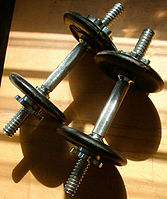
Photo from wikipedia
OBJECTIVE There is a lack of consensus on which abdominal or pelvic floor muscle (PFM) exercises to recommend for the treatment of diastasis recti abdominis (DRA). The objective of this… Click to show full abstract
OBJECTIVE There is a lack of consensus on which abdominal or pelvic floor muscle (PFM) exercises to recommend for the treatment of diastasis recti abdominis (DRA). The objective of this study is to investigate the immediate effect of abdominal and PFM exercises on interrecti distance (IRD) in women with DRA who are parous. METHODS In this cross-sectional study, 38 women who were parous, with a mean age of 36.2 years (SD = 5.2), diagnosed with DRA participated. IRD was assessed with 2D real-time ultrasonography during rest and during 8 randomly ordered different exercises. A paired t test was used to compare the IRD at rest with the IRD recorded during each exercise as well as the differences between exercises. Means with 95% CI are reported. RESULTS Head lift and twisted curl-up exercises significantly decreased the IRD both above and below the umbilicus. Above the umbilicus, the mean IRD difference from rest during head lift was 10 mm (95% CI = 7 to 13.2), whereas during twisted curl-up, it was 9.4 mm (95% CI = 6.3 to 12.5). Below the umbilicus, the corresponding values were 6.1 mm (95% CI = 3.2 to 8.9) and 3.5 mm (95% CI = 0.5 to 6.4), respectively, but PFM contraction, maximal in-drawing, and PFM contraction+maximal in-drawing increased the IRD (mean difference = -2.8 mm [95% CI = -5.2 to 0.5), -4.7 mm (95% CI = -7.2 to -2.1) and - 5.0 mm (95% CI = -7.9 to -2.1), respectively. CONCLUSIONS Head lift and twisted curl-up exercises decreased the IRD both above and below the umbilicus, whereas maximal in-drawing and PFM contraction exercises only increased the IRD below the umbilicus. A randomized controlled trial is needed to investigate whether head lift and twisted curl-up exercises are effective in permanently narrowing the IRD. IMPACT To date there is scant scientific knowledge of which exercises to recommend in the treatment of DRA. In-drawing and PFM contraction leads to an acute increase in IRD while head lift and twisted curl-up leads to an acute decrease in IRD in postpartum women. There is a need for high quality RCTs to investigate if there is a long-term reduction in IRD by doing these exercises over time. The acute IRD increase and decrease during the different exercises is also present in a sample of women with larger separations.
Journal Title: Physical therapy
Year Published: 2020
Link to full text (if available)
Share on Social Media: Sign Up to like & get
recommendations!